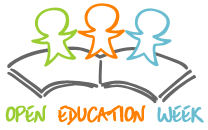From Sue Evans, Co-Founder and CEO
Many of us involved in e-learning and education are very excited about one very big idea: open education resources, or OER. It’s easy to find out who’s making them, where to find them and how to use them. However, it can be harder to articulate why your average teacher or professor should be as excited as we are. For years, we have been dependent on textbooks, learning management systems and lesson plans. Why add OER into the mix?
OER are educational materials that can be reused, shared and (sometimes) remixed to support teaching and learning. That means that they either exist in the public domain or use an alternative license, such as Creative Commons. This includes all types of learning content, including e-textbooks, lesson plans, videos, entire courses or the SoftChalk learning objects you find in SoftChalk CONNECT.
It’s a simple concept, but a radical one. We’ve worked in closed educational systems for eons. Schools have their own curricula, and textbooks conveniently package the knowledge needed to supplement lessons. Courses are only for the students at any given university, and copyrights keep us from integrating materials fully into our learning experiences.
Ever-expanding access to OER is helping create a new reality in education. We have an opportunity to move from these closed systems, working around one another, to a truly dynamic educational ecosystem. In a recent SoftChalk webinar, Catherine Casserly, CEO of Creative Commons did an excellent job of articulating exactly why educators should create and use OER:
- OER reduce transaction costs. Textbooks and other learning materials require educators to navigate copyright laws on a day-to-day basis. On the other hand, OER are either in the public domain or are clearly marked with who has a right to use them and how. In addition, instructors save time in selecting materials, since OER are already sorted into usable “gems.”
- OER can make planning and teaching more efficient. Every year, thousands of teachers in thousands of classrooms teach the same material. For example, how many universities offer “Introduction to Statistics?” We can use OER to reduce redundancy, giving instructors access to the best elements they need to create a quality course.
- OER recognize that learning is dynamic. Learning is hardly a static process, yet many classrooms use textbooks that relate the same stories about history the same way, no matter the interests or abilities of individual learners. Sometimes our very “facts” change; consider planetary cast-out Pluto. Access to OER not only allows instructors to respond to such changes, but also to respond to the needs of their students.
- OER are scalable. Unlike textbooks or packaged learning materials, OER can be expanded, remixed and reused for maximum impact. This is because copyleft materials are flexible by design. They encourage reuse and repurposing, whereas copyright materials actively discourage such uses. Plus, OER repositories and referral services make it easy to search for the perfect combination of materials.
For students, this means engaging learning materials that meet their needs. For administrators, this means less money spent on updating textbooks and other materials. And for educators, this means more efficient planning that keeps a world of information at their fingertips.
What’s your take on OER? Have you used or created any yet? Tell us about your experiences in the comments section. If you haven’t given OER a try yet, browse the selection of learning objects in the SoftChalk CONNECT repository.
Want more on OER? Register for our upcoming Open Education Week webinar 
SoftChalk users and Creating Courseware using SoftChalk and Open Educational Resources
This presentation will highlight how two educators used SoftChalk to transform traditional flat texts into engaging, interactive OER course materials.
As a key component of the Reading Curriculum Team for the Kaleidoscope Grant, Jacqui Cain developed an interactive reader using SoftChalk to adapt “The Hound of the Baskervilles” for use in lower-level basic skills courses. Ms. Cain will explain the collaboration process and creation of the materials, demonstrate the reader, discuss the next phases of this project and briefly review two OER projects currently in development.
Malissa Attebery from Lone Star College created a World War II ecourse using the OER textbook written by Henry Jud Sage, a Virginia Community College faculty member. His original etextbook is located in the College Open Textbooks repository. Using SoftChalk, this flat text was made interactive and portable to multiple web-based learning environments, enabling the learner to see, hear, and further explore the content.
Friday, March 9 2:00pm ET Register Now

Leave a Reply